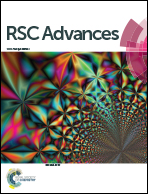Extract-mediated synthesis of Ag@AgCl nanoparticles using Conium maculatum seeds: characterization, antibacterial activity and cytotoxicity effect against MCF-7 cell line†
Abstract
In this study, silver/silver chloride nanoparticles (Ag@AgCl-NPs) were successfully synthesized using silver nitrate (AgNO3) via an eco-friendly and simple green approach using the seed extract of Conium maculatum (SECM) at room temperature. The biologically synthesized Ag@AgCl-NPs were characterized by UV-vis spectroscopy, transmission electron microscopy (TEM), scanning electron microscopy (SEM), energy dispersive X-ray spectroscopy (EDS) and X-ray diffraction (XRD). Electron microscopic imaging showed that the size of the Ag@AgCl-NPs was about 20 nm, with the particles spherical in shape. Moreover, the crystalline structure of the synthesized nanoparticles was confirmed using the XRD pattern. The potential antibacterial activity of the NPs against standard strains of human pathogens (Gram-positive and negative bacteria) and in vitro anticancer activity against the MCF-7 cell line were investigated. The results demonstrated the ability of the synthesized nanoparticle to kill the cancer cells and inhibit the growth of the human pathogenic and standard strains.



 Please wait while we load your content...
Please wait while we load your content...